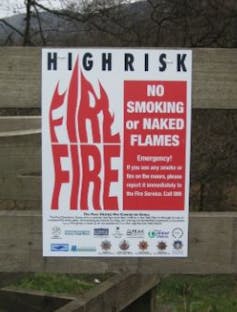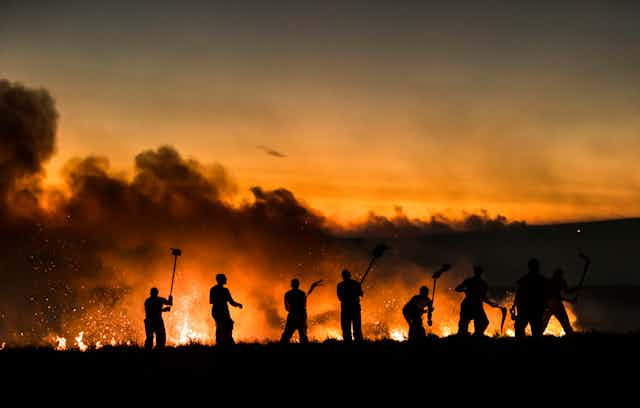The huge moorland fires at Saddleworth and Winter Hill in northwest England have shown just how serious a problem wildfires can be in the UK. Now the fires are out, it is time to look at how such catastrophes can be prevented in the future and why this critical environmental issue needs to be on the political agenda.
Our research has shown how informal local and national partnerships helped keep the flames under some form of control and can reduce the risk of future fires on this scale. But the government needs to support these partnerships and see wildfire as more than a fire service problem. Climate change will make such fires more common so the country must be ready.
Managing moorland wildfire risk is not just about putting out fires. It is also about reducing the risk of fires starting and spreading. This involves the cooperation of many diverse interest groups, so fire and rescue services work collaboratively with other stakeholders such as mountain rescue groups, local councils, police forces and government agencies. As the Scottish government wildfire manual (section 8A.20) acknowledges, it would be impossible for fire and rescue services to attempt to address the risks in isolation.
Partnerships in action
Fire crosses property and administrative boundaries so cooperation between agencies and interest groups is vital. Informal partnerships have developed to coordinate efforts. Local fire groups have formed to share expertise and firefighting equipment. The Peak District Fire Operations Group (FOG was one of the first. It is six local fire services, three water companies, amenity groups and other landowners working together to prevent and prepare for wildfires. There are now at least 20 such groups across the UK, spurred by bad fire seasons in 2003, 2006 and 2011. These collaborations, championed by Northumberland Fire and Rescue Service among others, have changed the approach to fighting UK wildfires.
Read more: How climate change is increasing the risk of wildfires
Fire groups train together and share resources. Standard gauge hoses now mean that fire brigades can join them together in a “water relay” to reach remote fires. The Peak District group includes Pennine helicopters – seen on the news dumping water on the moorland fires in Lancashire and Greater Manchester. The Lancashire FOG uses the Bay Search and Rescue’s large all-terrain vehicle – normally used to traverse Morecambe Bay’s sands – to ferry people and heavy equipment across soft peat moorland. Bolton Mountain Rescue served as tactical lookouts, spotting flare-ups at the Winter Hill fire. Land managers provide all-terrain vehicles and “fogging units” with fine sprays to wet vegetation, while countryside rangers and landowners bring local knowledge of the terrain.
Formal multi-agency working is also required at major incidents, including help from other emergency services, the military and utility companies.
Sharing the lessons
There is no separate national fire service for wildfires. Instead, the UK’s 54 fire services help each other, so wildfire training is vital for all crews.
Saddleworth Moor fire crews had help from a Wildfire Tactical Advisor, one of a new national “flying squad” of specially trained regional officers, recently set up by the National Fire Chiefs Council Wildfire Group.
The England and Wales Wildfire Forum and its Scottish equivalent share good practice nationally and raise awareness of wildfire issues. Although unfunded, they have become the “go-to” bodies for government on wildfire issues.
They collaborate with UK wildfire researchers to match practitioners’ needs with wildfire research expertise, although many research gaps still remain. Critically, the UK does not have a suitable fire danger rating system to predict when and where wildfires will occur and their impacts.
Read more: A high-adrenaline job: 5 questions answered about fighting wildfires
Key fire service personnel in the UK have also gained valuable skills through international collaboration – for example, with the Pau Costa Foundation in Catalonia and the US’s Prescribed Fire Training Exchange (TREX). They learned how to predict wildfire behaviour by reading the landscape. Fire travels faster upwards on sunlit slopes and with the wind. Crews now use this knowledge in what is called indirect attack – this involves “starving” strategic locations in the fire’s path of fuel by mechanical clearing or controlled “defensive burning”.

National policy
A more robust planning and prevention approach to wildfire has evolved over the last 20 years, thanks to these informal local and national partnerships and international training. But the UK’s wildfire problem has only recently been recognised by national policy. Major fires in 2011 were a catalyst for severe wildfire to be included in the National Risk Register. The Natural Hazard Partnership now includes wildfire in its daily hazard assessments.
Read more: How the land recovers from wildfires – an expert's view
Local and national partnerships have proved an effective response, despite stretched resources, and deserve government support. Without these bottom-up initiatives, fire crews fighting the blazes on Saddleworth Moor and Winter Hill would have had an even more arduous task.
Wildfire is more than just a fire service issue. Any change in land use or land management which affects ignition sources (people) or fuel (vegetation) can also change wildfire risk, whether deliberately or unintentionally. Either way, planning ahead to manage wildfire risk should be firmly on the political agenda.

